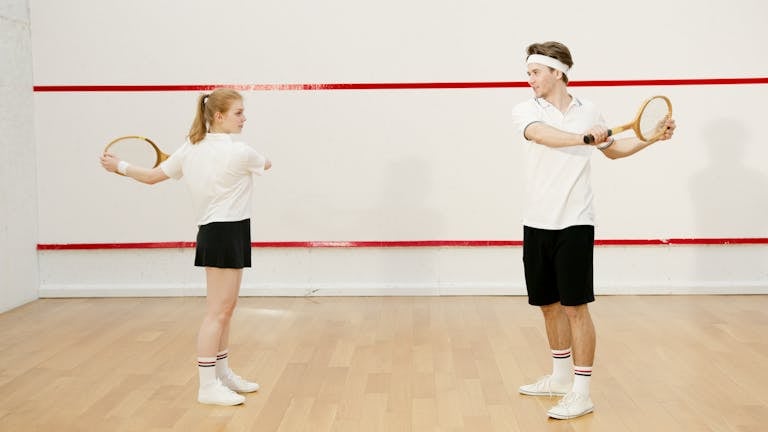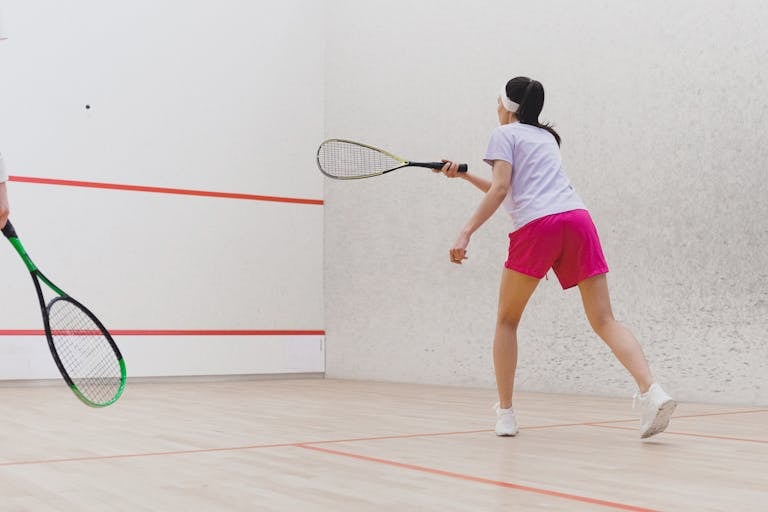Squash is one of the world’s fastest-paced racket sports, played indoors on a four-walled, enclosed court. Players use a small, hollow, rubber ball and long-handled rackets to compete in singles or doubles matches. The game is very physically and mentally demanding as the combination of strategy, agility, and shot placement required makes the game extremely competitive.
Squash courts have distinct lines that dictate where players should hit the ball. Then there’s the type of ball used, which further impacts its bounce, making the game even more complex. Having originated in the 19th century, squash has expanded worldwide and ranks among the most popular sports, finding millions of current players.
Besides being tons of fun, squash offers a complete body workout—boosting cardiovascular health, coordination, and endurance. Squash continues to be a leading destination for players of all ages who are looking for both fitness and fun.
Key Takeaways
- Squash is a thrilling indoor racquet sport that requires speed, stamina, and shrewdness. Two players or teams face off in a four-walled court, exhibiting their agility and intensity.
- In squash, players alternately hit a small rubber ball against a wall after it bounces once. Matches are typically played to 11 or 15 points.
- A regular squash court has distinctive features like service boxes, a tin, and out-of-bounds areas that affect the game.
- Becoming a squash pro means mastering the right form and swing, working on your footwork, and creating a smart offensive and defensive gameplan.
- Major differences between squash and racquetball include court design, equipment used, and rules of gameplay. Squash usually provides a higher-tempo, more dynamic pace that requires more accuracy.
- Through repeated practice and training, squash players develop their hand-eye coordination, reaction time, and overall performance on the court.
What is Squash as a Sport

1. Define squash in sports
Squash is a fast-paced, challenging, and fun indoor racquet sport that requires agility, strategy, and endurance. Players use heavy, long-handled racquets and a small rubber ball. That’s because this special ball will bounce much less, requiring super fast reflexes and impressive accuracy.
The sport is played on a four-walled, indoor court. The four walls are the unsung heroes, allowing the small ball to bounce back to players during the most explosive rallies. Squash developed from the 19th century game of rackets. Starting out in London jails of the 1800s, it developed into the agile, international game we play and watch in present day.
After WWII, the sport skyrocketed in popularity throughout the world. It quickly grew to become integral in larger international competitions, like the 1986 Asian Games and 1998 Commonwealth Games. With approval for the 2028 Summer Olympics in Los Angeles, squash has cemented its position as a globally recognized sport.
2. Explain squash game rules
The rules in squash are easy to learn but require concentration. Players take turns returning the ball after its first bounce, trying to keep long rallies with their opponents while putting pressure on their opponent’s positioning. The player serving begins the rally by striking the ball against the front wall, making sure it bounces within the opponent’s service box.
Faults happen when the ball bounces twice before being played or goes into out-of-bounds zones. Scoring usually goes by the Point-A-Rally System (PARS), with matches played to 11 points. This new scoring format overrode the previous “HiHo” style. It had its pushback, particularly from old-timer players.
Variations like playing to 15 points per game are common too, giving a lot of leeway in how competition can happen.
3. Highlight squash court layout
A typical squash court measures 20 feet in width and 32 feet in length, surrounded by four walls. The front wall is marked with a service line and a lower “tin,” which serves as a boundary line. The side walls and back wall are important as well, as players use these walls to hit angled shots that wouldn’t be possible otherwise.
Service boxes indicate where players must serve from, and out-of-bounds lines help maintain order in the game. Doubles courts are used for team matches and are 25 feet wide, 45 feet long. They need at least a 24-foot ceiling height.
These courts especially suit the faster pace and wider angles of doubles play.
How to Play Squash
1. Learn Basic Squash Techniques
If you want to get on the squash court and play at your best, you’ll have to start with the fundamentals. Playing squash – step one – get the grip right! Grip the racket as though you are shaking hands with it. Maintain a strong but loose grip for improved accuracy.
You want your stance to be a bit open, knees flexed, feet shoulder-width apart, poised to accelerate in any direction. After that, move on to practicing all sorts of shots. Drives are your power shots, straight down the sidewalls to cut off your opponent’s angles.
Drops are a type of softer shot that barely clears the tin, making your opponent run to the front of the court. Lobs are high, slow shots that make your opponent run to the back of the court. The one thing that matters is consistency. Devote time in practice to working on hitting the ball cleanly and accurately. Concentrate on hitting it precisely where you want!
2. Understand Squash Scoring System
Squash uses two main scoring systems: the traditional “Hand-In-Hand-Out” (HiHo) and the more common “Point-A-Rally” (PARS). In HiHo, only the server can score, but PARS gives a point on every rally, no matter who serves.
Players score a point each time their opponent does not return the ball cleanly into the defined court lines. For instance, the ball must bounce off the front wall before it bounces on the ground. Terms to know include:
- Game: A single segment of play, usually up to 11 points in PARS.
- Set: A tie-breaking extension, often to 15 points.
- Match: The complete contest, typically best of 3 or 5 games.
3. Master Essential Gameplay Strategies
A good strategic positioning statement is absolutely critical. Keep close to the middle “T” zone, giving you the ability to cover the court effectively. Watch for your opponent’s tendencies to find leaks, such as being slower to react to drop shots.
Smartly alternate your shot selection between aggressive shots to maintain pressure on your opponent and retrieving shots to regroup and reset the rally.
4. Practice Effective Footwork in Squash
As always, quick and precise footwork allows you to stay in control even in frantic, toe-to-toe rallies. Practice movements from side-to-side, forward and back. Drills such as ghosting—where you mimic movements of actual play without the ball—build your agility and stamina.
Maintaining good balance in between shots will help you have more control and make fewer mistakes.
5. Develop Hand-Eye Coordination Skills
Better hand-eye coordination helps your timing and placement become more precise. Drill things such as volleying the ball continuously back to a wall, working on your height and targeting.
Reaction-based drills, like reacting to random ball bounces, help increase split-second decision-making. Being consistent in practice develops muscle memory which will help you perform better overall.
Squash vs Racquetball Differences
1. Compare Equipment Used in Both Sports
The equipment used in squash and racquetball is quite different, greatly influencing the style of play in both sports. Squash employs a racket that is also 27 inches long but with a significantly smaller head. This unique design focuses on precision and control, which are invaluable in a quick, fast-paced game where the ball travels at high speeds in an enclosed court.
In contrast, racquetball uses a racquet that’s shorter (22 inches) and has a teardrop-shaped head. This design favors power, allowing for easier creation of forceful shots. The balls used in each sport are different as well. Squash balls are smaller, measuring 1.6 inches in diameter, and made of rubber. They differ in how much they bounce and how fast they go, as shown by colored dots such as yellow or blue.
Racquetball balls are larger (2.25 inches) and much more bouncy, adding to the speed and intensity of the sport. Protective gear is a factor. Clearly, both sports require proper eyewear. Racquetball players usually prefer thicker goggles since the ball travels at such high speeds. Shoes for both sports focus on grip and lateral movement to the greatest extent, though racquetball shoes can provide additional cushioning for the shocks of a hard court.
2. Highlight Differences in Court Design
Squash courts are completely surrounded on all four sides, with a front wall, two side walls, and a back wall. The court measures out 32 feet in length and 21 feet in width. It has clearly defined service boxes and a tin fixed to the bottom of the front wall. Racquetball courts are slightly larger at 40 feet long and 20 feet wide, with all walls, including the ceiling, being playable surfaces.
Key differences include:
- Squash: Lower tin, no ceiling play.
- Racquetball: Higher walls, ceiling included in gameplay.
| Feature | Squash | Racquetball |
|---|---|---|
| Racket Length | 27 inches | 22 inches |
| Ball Diameter | 1.6 inches | 2.25 inches |
| Court Size | 32 ft x 21 ft | 40 ft x 20 ft |
| Playable Surfaces | Front, side, back walls | All walls, including ceiling |
3. Contrast Gameplay Rules and Strategies
Squash players serve from the service box and must serve to the opposite quarter of the court. Matches are the best of five games, with each game played to 11 points. Like squash, players are required to win by 2. Racquetball, on the other hand, begins with a serve that requires the ball to bounce off the ground first before it hits the front wall. Matches usually play to 15 points. The winner is the first player that wins two of three games.
Tactically, squash is a game of precision and stamina. The smaller court and less lively ball require very accurate strokes and strategic footwork. Racquetball requires an extreme level of strength and hand-eye coordination. The lively ball and large court allow for quick rallies and powerful shots.
4. Explain the Pace and Intensity of Each Game
Squash is a game that pushes your endurance. Players need to be able to accelerate over short distances in a hurry and maintain concentration on accurately placing a ball. The slower ball and smaller court demand constant conditioning and mental capacity.
Racquetball tends to be more explosive, featuring longer rallies and less time between points. The bouncier ball and larger court create a much quicker pace, demanding quickness and reflexes over stamina. Both sports require mental stamina to remain focused through long matches.
Conclusion
Squash is an exciting, challenging, and highly-rewarding sport that combines strategy with athleticism. It’s an excellent way to support your physical fitness, improve your reflexes, and have some good-natured competition.
Whether you’re a beginner or an advanced player, squash provides excitement and competition for people of all ages and abilities. The contrasts between squash and racquetball may appear small upon first inspection. Understanding these differences will make you a more informed player and ensure you find the version of the game that’s right for you.
Pick up a racquet, locate a court and discover how squash can fit into your life. In each match, you’ll develop strength, agility and passion for the game. Give it a shot and you’ll be amazed at what it can do for your fitness level and overall mental attitude.
Frequently Asked Questions
What is squash as a sport?
A high-energy racquet sport played in an indoor four-walled court. In squash, two players use rackets to hit a small, hollow, rubber ball against four walls, trying to outsmart one another. It’s one of the most comprehensive workouts, developing agility, stamina and hand-eye coordination.
How is squash different from racquetball?
The primary differences—the ball and court size. Squash employs a smaller, less bouncy ball and features a narrower court. The rules and gameplay are so different that each sport really is a completely distinct experience.
What equipment do you need to play squash?
To play squash, you’ll use a squash racket, a squash ball, and you’ll need non-marking shoes. Protective eyewear should be considered as well for personal safety.
Can beginners play squash?
Yes, squash is for beginners. Provide a slower ball to help them feel more in control and allow them to focus on fundamentals. It’s simple to learn and provides a fantastic workout.
How many calories can you burn playing squash?
Squash can burn around 500-800 calories an hour, based on the level of play. …It’s a great sport in terms of exercise.
Is squash a good workout?
Squash is an incredible high-intensity, full-body workout. It strengthens your cardiovascular health while building muscle strength and improving coordination and reflexes.
How long does a squash game last?
A regular game of squash will take about 20-40 minutes, with the time varying depending on the caliber and pace of play of the participants. Matches are typically one game but can be best of three or five games.


